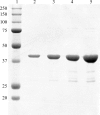Crystallization and preliminary crystallographic characterization of glutamine synthetase from Medicago truncatula
- PMID: 20054137
- PMCID: PMC2802889
- DOI: 10.1107/S1744309109047381
Crystallization and preliminary crystallographic characterization of glutamine synthetase from Medicago truncatula
Abstract
The condensation of ammonium and glutamate into glutamine catalyzed by glutamine synthetase (GS) is a fundamental step in nitrogen metabolism in all kingdoms of life. In plants, this is preceded by the reduction of inorganic nitrogen to an ammonium ion and therefore effectively articulates nitrogen fixation and metabolism. Although the three-dimensional structure of the dodecameric bacterial GS was determined quite some time ago, the quaternary architecture of the plant enzyme has long been assumed to be octameric, mostly on the basis of low-resolution electron-microscopy studies. Recently, the crystallographic structure of a monocotyledonous plant GS was reported that revealed a homodecameric organization. In order to unambiguously establish the quaternary architecture of GS from dicotyledonous plants, GS1a from the model legume Medicago truncatula was overexpressed, purified and crystallized. The collection of synchrotron diffraction data to 2.35 A resolution allowed the determination of the three-dimensional structure of this enzyme by molecular replacement.
Figures


Similar articles
-
The structures of cytosolic and plastid-located glutamine synthetases from Medicago truncatula reveal a common and dynamic architecture.Acta Crystallogr D Biol Crystallogr. 2014 Apr;70(Pt 4):981-93. doi: 10.1107/S1399004713034718. Epub 2014 Mar 19. Acta Crystallogr D Biol Crystallogr. 2014. PMID: 24699643 Free PMC article.
-
Glutamine synthetase in Medicago truncatula, unveiling new secrets of a very old enzyme.Front Plant Sci. 2015 Jul 27;6:578. doi: 10.3389/fpls.2015.00578. eCollection 2015. Front Plant Sci. 2015. PMID: 26284094 Free PMC article. Review.
-
Medicago truncatula contains a second gene encoding a plastid located glutamine synthetase exclusively expressed in developing seeds.BMC Plant Biol. 2010 Aug 19;10:183. doi: 10.1186/1471-2229-10-183. BMC Plant Biol. 2010. PMID: 20723225 Free PMC article.
-
Glutamine synthetase is a molecular target of nitric oxide in root nodules of Medicago truncatula and is regulated by tyrosine nitration.Plant Physiol. 2011 Nov;157(3):1505-17. doi: 10.1104/pp.111.186056. Epub 2011 Sep 13. Plant Physiol. 2011. PMID: 21914816 Free PMC article.
-
Glutamine synthetase in legumes: recent advances in enzyme structure and functional genomics.Int J Mol Sci. 2012;13(7):7994-8024. doi: 10.3390/ijms13077994. Epub 2012 Jun 28. Int J Mol Sci. 2012. PMID: 22942686 Free PMC article. Review.
Cited by
-
The structures of cytosolic and plastid-located glutamine synthetases from Medicago truncatula reveal a common and dynamic architecture.Acta Crystallogr D Biol Crystallogr. 2014 Apr;70(Pt 4):981-93. doi: 10.1107/S1399004713034718. Epub 2014 Mar 19. Acta Crystallogr D Biol Crystallogr. 2014. PMID: 24699643 Free PMC article.
-
Glutamine synthetase in Medicago truncatula, unveiling new secrets of a very old enzyme.Front Plant Sci. 2015 Jul 27;6:578. doi: 10.3389/fpls.2015.00578. eCollection 2015. Front Plant Sci. 2015. PMID: 26284094 Free PMC article. Review.
-
New isoforms and assembly of glutamine synthetase in the leaf of wheat (Triticum aestivum L.).J Exp Bot. 2015 Nov;66(21):6827-34. doi: 10.1093/jxb/erv388. Epub 2015 Aug 24. J Exp Bot. 2015. PMID: 26307137 Free PMC article.
-
Polyamine and Ethanolamine Metabolism in Bacteria as an Important Component of Nitrogen Assimilation for Survival and Pathogenicity.Med Sci (Basel). 2022 Jul 29;10(3):40. doi: 10.3390/medsci10030040. Med Sci (Basel). 2022. PMID: 35997332 Free PMC article. Review.
-
Identification of an essential cysteinyl residue for the structure of glutamine synthetase alpha from Phaseolus vulgaris.Planta. 2010 Apr;231(5):1101-11. doi: 10.1007/s00425-010-1115-z. Epub 2010 Feb 21. Planta. 2010. PMID: 20237895
References
-
- Almassy, R. J., Janson, C. A., Hamlin, R., Xuong, N.-H. & Eisenberg, D. (1986). Nature (London), 323, 304–309. - PubMed
-
- Carvalho, H., Sunkel, C., Salema, R. & Cullimore, J. V. (1997). Plant Mol. Biol.35, 623–632. - PubMed
-
- Collaborative Computational Project, Number 4 (1994). Acta Cryst. D50, 760–763. - PubMed
-
- Eisenberg, D., Almassy, R. J., Janson, C. A., Chapman, M. S., Suh, S. W., Cascio, D. & Smith, W. W. (1987). Cold Spring Harb. Symp. Quant. Biol.52, 483–490. - PubMed
-
- Eisenberg, D., Gill, H. S., Pfluegl, G. M. & Rotstein, S. H. (2000). Biochim. Biophys. Acta, 1477, 122–145. - PubMed
Publication types
MeSH terms
Substances
LinkOut - more resources
Full Text Sources

